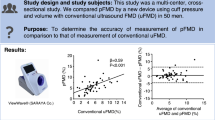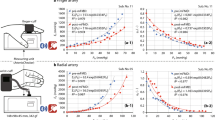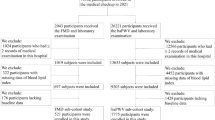Abstract
Vascular endothelial dysfunction represents an initial step of “vascular failure,” which we have recently proposed as a comprehensive syndrome of failed vascular functions that extends from risk factors to established atherosclerotic disease. The early detection of vascular failure is essential in order to appropriately intervene and prevent its progression. Many efforts have been made to assess vascular endothelial function, and one of the most promising methods is the measurement of endothelium-dependent flow-mediated vasodilation (FMD) using high-frequency ultrasonographic imaging and transient occlusion of the brachial artery. The reactive hyperemia caused by the transient brachial arterial occlusion induces the release of local nitric oxide, resulting in vasodilation that can be quantified as an index of vasomotor function. The noninvasive nature of this technique allows repeated measurements over time to study the effectiveness of various interventions that may affect vascular health. Although there are technical and interpretive limitations of this technique, FMD-guided therapeutic approaches for vascular failure should contribute to the improvement of cardiovascular mortality and morbidity.
Similar content being viewed by others
Article PDF
References
Inoue T, Node K : Vascular failure—a new clinical entity for vascular disease—. J Hypertens 2006; 24: 2121–2130.
Inoue T, Node K : Statin therapy for vascular failure. Cardiovasc Drug Ther 2007; 21: 251–258.
Luscher TF, Barton M : Biology of the endothelium. Clin Cardiol 1997; 20: 3–10.
Furchgott RF, Zawadzki JV : The obligatory role of endothelial cells in the relaxation of arterial smooth muscle by acetylcholine. Nature 1980; 288: 373–376.
Forstermann U, Munzel T : Endothelial nitric oxide synthase in vascular didsease. Circulation 2006; 113: 1708–1714.
Busse R, Edwards G, Feletou M, Fleming I, Vanhouutte PM, Weston AH : EDHF: bringing the concept together. Trend Pharmacol Sci 2002; 3: 374–380.
Lerman A, Burnet JC Jr : Intact and altered endothelium in regulation of vasomotion. Circulation 1992; 86: III-12–III-19.
Anderson TJ : Assessment and treatment of endothelial dysfunction in humans. J Am Coll Cardiol 1999; 34: 631–638.
Suwaidi JA, Hamasaki S, Higano ST, Nishimura RA, Holmes DR Jr, Lerman A : Long-term follow-up of patients with mild coronary artery disease and endothelial dysfunction. Circulation 2000; 101: 948–954.
Schächinger V, Britten MB, Zeiher AM : Prognostic impact of coronary vasodilator dysfunction on adverse long-term outcome of coronary heart disease. Circulation 2000; 101: 1899–1906.
Halcox JP, Schenke WH, Zalos G, et al: Prognostic value of coronary vascular endothelial dysfunction. Circulation 2002; 106: 653–658.
Perticone F, Ceravolo R, Pujia A, et al: Prognostic significance of endeothelial dysfunction in hypertensive patients. Circulation 2001; 104: 191–196.
Heitzer T, Schlinzig T, Krohn K, Meinertz T, Münzel T : Endothelial dysfunction, oxidative stress, and risk of cardiovascular events in patients with coronary artery disease. Circulation 2001; 104: 2673–2678.
Gokce N, Keaney JF Jr, Hunter LM, Watkins MT, Menzoian JO, Vita JA : Risk stratification for postoperative cardiovascular events via noninvasive assessment of endothelial function: a prospective study. Circulation 2002; 105: 1567–1572.
Rassaf T, Feelisch M, Kelm M : Circulating NO pool: assessment of nitrite and nitroso species in blood and tissues. Free Radic Biol Med 2004; 36: 413–422.
Vallance P, Leiper J : Cardiovascular biology of the asymmetric dimethylarginine:dimethylaminohydrolase pathway. Arterioscler Thromb Vasc Biol 2004; 24: 1023–1030.
Boger RH, Maas R, Schulze F, Schwedheim E : Elevated levels of asymmetric dimethylarginine (ADMA) as a marker of cardiovascular disease and mortality. Clin Chem Lab Med 2005; 43: 1124–1129.
Ridker PM, Brown NJ, Vaughan DE, Harrison DG, Mehta JL : Established and emerging plasma biomarkers in the prediction of first atherothrombotic events. Circulation 2004; 109: IV6–IV19.
Rifai N, Ridker PM : Inflammatory markers and coronary heart disease. Curr Opin Lipidol 2002; 13: 383–389.
Vaughan DE : PAI-1 and atherothrombosis. J Thromb Haemost 2005; 3: 1879–1883.
Mannucci PM : von Willebrand factor: a marker of endothelial damage? Arterioscler Thromb Vasc Biol 1998; 18: 1359–1362.
Werner N, Wassmann S, Ahlers P, Kosiol S, Nickenig G : Circulating CD31+/annexin V+ apoptotic microparticles correlate with coronary endothelial function in patients with coronary artery disease. Arterioscler Thromb Vasc Biol 2006; 26: 112–116.
Diamant M, Tushuizen ME, Sturk A, Nieuwland R : Cellular microparticles: new players in the field of vascular disease? Eur J Clin Invest 2004; 34: 392–401.
Werner N, Nickenig G : Clinical and therapeutical implications of EPC biology in atherosclerosis. J Cell Mol Med 2006; 10: 318–332.
Ludmer PL, Selwyn AP, Shook TL, et al: Paradoxical vasoconstriction induced by acetylcholine in atherosclerotic coronary arteries. N Engl J Med 1986; 315: 1046–1051.
Furchgott RF : Role of endothelium in responses of vascular smooth muscle. Circ Res 1983; 53: 984–989.
Vanhoutte PM, Rimele TJ : Role of endothelium in the control of vascular endothelial function. J Physiol (Paris) 1983; 78: 681–689.
Werns SW, Walton JA, Hsia HH, Nabel EG, Sanz ML, Pitt B : Evidence of endothelial dysfunction in angigraphically normal coronary arteries of patients with coronary artery disease. Circulation 1989; 79: 287–291.
Horio Y, Yasue H, Rokutanda M, et al: Effects of intracoronary injection of acetylcholine on coronary artery diameter. Am J Cardiol 1986; 57: 984–989.
Egashira K, Inou T, Hirooka Y, Yamada A, Urabe Y, Takeshita A : Evidence of impaired endothelium-dependent coronary vasodilatation in patients with angina pectoris and normal coronary angiogram. N Engl J Med 1993; 328: 1659–1664.
Inoue T, Sakai Y, Morooka S, et al: Vasodilatory capacity of coronary resistance vessels in dilated cardiomyopathy. Am Heart J 1994; 127: 376–381.
Wu HD, Katz SD, Beniaminovitz A, et al: Assessment of endothelium-mediated vasodilation of the peripheral circulation by transcutaneous ultrasonography and venous occlusion plethysmography. Heart Vessels 1999; 14: 143–148.
Higashi Y, Yoshizumi M : New method to evaluate endothelial function: method for assessing endothelial function in humans using a strain-gauge plethysmography: nitric oxide dependent and independent vasodilation. J Pharmacol Sci 2003; 93: 399–404.
Olsen SP, Clapham DE, Davis PF : Hemodynamic shear stress activates a K+ current in endothelial cells. Nature 1998; 331: 168–170.
Anderson TJ, Uehata A, Gerhard MD, et al: Close relation of endothelial function in the human coronary and peripheral circulations. J Am Coll Cardiol 1995; 26: 1235–1241.
Corretti MC, Anderson TJ, Benjamin EJ, et al: Guidelines for the ultrasound assessment of endothelial-dependent flow-mediated vasodilatation of the brachial artery. J Am Coll Cardiol 2002; 39: 257–265.
Hayward CS, Kraidly M, Webb CM, Collins P : Assessment of endothelial function using peripheral waveform analysis: a clinical application. J Am Coll Cardiol 2002; 40: 521–528.
Bonetti PO, Pumper GM, Higano ST, Holmes DR Jr, Kuvin JT, Lerman A : Noninvasive identification of patients with early coronary atherosclerosis by assessment of digital reactive hyperemia. J Am Coll Cardiol 2004; 44: 2137–2141.
Naka KK, Tweddel AC, Doshi SN, Goodfellow J, Henderson AH : Flow-mediated changes in pulse wave velocity: a new clinical measure of endothelial function. Eur Heart J 2006; 27: 302–309.
Hashimoto M, Eto M, Akishita M, et al: Modulation of endothelium dependent flow-mediated dilatation of the brachial artery by sex and menstrual cycle. Circulation 1995; 92: 3431–3435.
Uehata A, Lieberman EH, Gerhard MD, et al: Noninvasive assessment of endothelium-dependent flow-mediated dilation of the brachial artery. Vasc Med 1997; 2: 87–92.
Corretti MC, Plotnick GD, Vogel RA : Technical aspects of evaluating brachial artery vasodilatation using high-frequency ultrasound. Am J Physiol 1995; 268: H1397–H1404.
Black MA, Cable T, Thijssen DHJ, Green DJ : Importance of measuring the time course of flow-mediated dilatation in humans. Hypertension 2008; 51: 203–210.
Panza JA, Quyyumi AA, Brush JEJ, Epstein SE : Abnormal endothelium-dependent vascular relaxation in patients with essential hypertension. N Engl J Med 1990; 323: 22–27.
Mannion TC, Vita JA, Keaney JF Jr, Benjamin EJ, Hunter L, Polak JF : Non-invasive assessment of brachial artery endothelial vasomotor function: the effect of cuff position on level of discomfort and vasomotor responses. Vasc Med 1998; 3: 263–267.
Vogel RA, Corretti MC, Plotnick GD : A comparison of the assessmentof flow-mediated brachial artery vasodilation using upper versus lower arm arterial occlusion in subjects with and without coronary risk factors. Clin Cardiol 2000; 23: 571–575.
Guthikonda S, Sinky CA, Haynes WG : What is the most appropriate methodology for detection of conduit artery endothelial dysfunction. Arterioscler Thromb Vasc Biol 2007; 27: 1172–1176.
Ducharme A, Dupuis J, McNicoll S, Harel F, Tardif JC : Comparison of nitroglycerin lingual spray and sublingual tablet on time of onset and duration of brachial artery vasodilation in normal subjects. Am J Cardiol 1999; 84: 952–954.
Craiema D, Chironib G, Gariepyb J, Miranda-Lacetb J, Levensonb J, Simonb A : New monitoring software for larger clinical application of brachial artery flow-mediated vasodilatation measurements. J Hypertens 2007; 25: 133–140.
Anderson EA, Mark AL : Flow-mediated and reflex changes in large peripheral artery tone in humans. Circulation 1989; 79: 93–100.
Celermajer DS, Sorensen KE, Bull C, et al: Endotheliumdependent dilation in the systemic arteries of asymptomatic subjects relates to coronary risk factors and their interaction. J Am Coll Cardiol 1994; 24: 1468–1474.
Silber HA, Ouyang P, Bluemke DA, et al: Why is flowmediated dilation dependent on arterial size? Assessment of shear stimulus using phase-contrast magnetic resonance imaging. Am J Physiol Heart Circ Physiol 2005; 288: H822–H828.
Mizia-Stec K, Gasior Z, Mizia M, et al: Flow-mediated dilation and gender in patients with coronary artery disease: arterial size influences gender differences in flow-mediated dilation. Ecocardiography 2007; 24: 1051–1057.
Hijmering ML, Stroes ESG, Olijhoek J, Hutten BA, Blankestijn PJ, Rabelink TJ : Sympathetic activation markedly reduces endothelium-dependent, flow-mediated vasodilation. J Am Coll Cardiol 2002; 39: 683–688.
Author information
Authors and Affiliations
Consortia
Corresponding author
Rights and permissions
About this article
Cite this article
Inoue, T., Matsuoka, H., Higashi, Y. et al. Flow-Mediated Vasodilation as a Diagnostic Modality for Vascular Failure. Hypertens Res 31, 2105–2113 (2008). https://doi.org/10.1291/hypres.31.2105
Received:
Accepted:
Issue date:
DOI: https://doi.org/10.1291/hypres.31.2105
Keywords
This article is cited by
-
Seasonal variations in endothelium-dependent flow-mediated vasodilation and endothelium-independent nitroglycerine-induced vasodilation
Hypertension Research (2024)
-
Long-term cardiovascular consequences of adolescent anorexia nervosa
Pediatric Research (2023)
-
Optimal uric acid reduction to improve vascular endothelial function in patients with chronic heart failure complicated by hyperuricemia
Hypertension Research (2023)
-
Does body height affect vascular function?
Hypertension Research (2022)
-
Dapagliflozin effect on endothelial dysfunction in diabetic patients with atherosclerotic disease: a randomized active-controlled trial
Cardiovascular Diabetology (2021)



